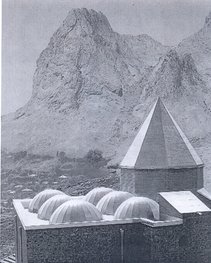UDC: 7.033.3(479.24)"14/15"
COBISS.SR-ID 229887756
Received:November 15,2016/
Reviewed:February 13,2017/
Accepted:February 15,2017
Poetry and Music of Medieval Azerbaijani Ashygs
in the Context of Mystic Practices
Sanubar Baghirova
Azerbaijan National Academy of Sciences Institute of Architecture and Arts.
Department for History & Theory of Traditional Music, Azerbaijan
[email protected]
Azerbaijan National Academy of Sciences Institute of Architecture and Arts.
Department for History & Theory of Traditional Music, Azerbaijan
[email protected]
|
Citation:
Baghirova, Sanubar. 2017. “Poetry and Music of Medieval Azerbaijani Ashygs in the Context of Mystic Practices.” Accelerando: Belgrade Journal of Music and Dance 2:7.
Acknowledgements
The author is pleased to thank Professor Maharram Gasimli for sharing his knowledge of some ancient Azerbaijani words and terms with me, Professor Chingiz Qajar, corresponding member of the Azerbaijan National Academy of Sciences, for giving me the photos of the old Dervish khanegah in Nakhchivan, ashyg Ramin Garayev for giving me the ashyg song Urfani in his rendition, and ashyg Mehemmedeli Meshediyev for e-mailing me the recording of the ashyg song Ibrahimi. |
abstract
This article focuses on poetry and music of the medieval Azerbaijani ashyg in the context of mystic practices. The ashygs are the bearers of the syncretic art form that came into being at the end of the 15th – early of the 16th centuries and has reached to date. Both medieval and modern ashygs – ustads (masters) were and are poets, composers and performers in one person. Poetry of early medieval ashygs, such as, Dirili Gurbani, Miskin Abdal (15th -16th century), Abbas Tufarganly, Khaste Gasym, Sary Ashyg (17th century) was thought to convey the God`s message; these ashygs called themselves ‘haqq ashiqi’, that is ‘those who fell in love with Truth’ meaning by Truth the Higher Principle, the Absolute. Some of the early ashygs, for instance, Dirili Gurbani and Miskin Abdal, were Sufi mystics and members of Sufi brotherhoods. Poetry and music of the medieval Azerbaijani ashygs was often a part of the Zikr, the mystic musical rites of sama` practiced by various Sufi dervish orders. A number of songs from the repertoire of modern ashyg sometimes are called ‘samavi havalar’ (sama` tunes) and do sound particularly archaic; it is believed to date back to the music performed at sama`. In the 19th century the art of ashyg lost its ideological function but religious and mystical motifs remained an inspiration for the ashyg even in the 20th century. These motifs were mainly associated with the name and cult of Imam Ali, the son-in-law of the Prophet Muhammad, and the Twelve Imams. Core notions of the article are: Ashyg, ’haqq ashiqi’, sama`, zikr, madh, meddah of Imam Ali, mürid, mürshid, khanegah, tekye.
Keywords: Sufi poets, spiritual tunes, Azerbaijani ashyg songs, diviani poems, dervish mystic musical rites |
(Əlizadə 1995, 18. Translation by the author)
Note: Shahi-Mardan is atraditional addressing to Imam Ali.
In the Soviet times religious and mystical motifs practically disappeared from the ashyg poetry, but the traditional beginning of an ashyg mejlis (literary and music party) with an opening exlamatory phrase “Ya İlahi, ya Mövlam, уa şahi-Mərdan, səndən mədəd!” («Оh, God, oh, my Master, oh, shahi-Mardan, help me!), i.e. with the addressing to God and to Imam Ali, still existing up today. Nevertheless, the art of modern Azerbaijani ashyg is thoroughly secular; it is not used in dervish rites any longer. Mystical and dervish practices in Azerbaijan have been twined around the Mugham since the 19th century, and the art of Mugham became another major genre of Azerbaijani traditional music. But this is the topic of the second part of this work.
references
Discography
|
This website is under Attribution-NonCommercial-NoDerivatives 4.0 International (CC BY-NC-ND 4.0)
Belgrade Center for Music and Dance is the publisher of Accelerando: BJMD
Belgrade Center for Music and Dance is the publisher of Accelerando: BJMD



